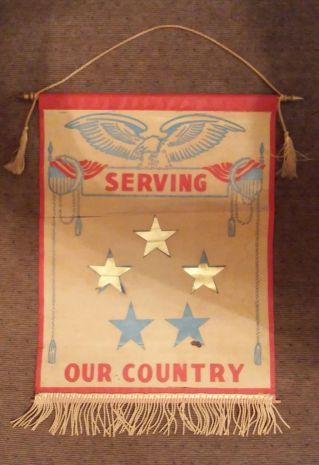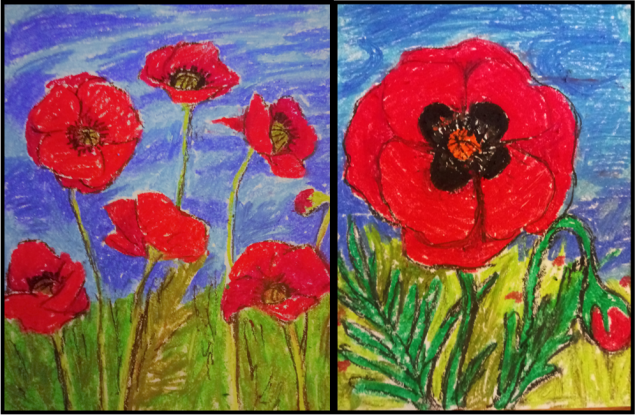
One hundred and three years ago today, “The War to End All Wars” ended. The armistice that brought about the end of World War I went into effect in 1918 on November 11, 11 a.m.
Several nations still mark this day and use it as a chance to remember this significant event. In places like Canada and Britain, it is known as “Remembrance Day.” In the United States, our calendars mark every 11/11 as “Veterans Day.”*
People observe this day and honor those who serve in various ways—ceremonies, moments of silence, creating displays featuring red poppies.

Along with this day of remembrance, the years of World War I also gave rise to another symbol to recognize those who served and sacrificed: the blue star and gold star banners.
This tradition was brought back to my attention when driving through Bremerton, WA. While some towns I have visited have flower baskets or decorative banners hanging from light posts on the streets, when I took the exit into Bremerton I noticed these.

The blue star banner was designed and patented in 1917 by Robert L. Queisser. Queisser was a veteran himself, and he had two sons serving overseas. The banners became quite popular. Bearing one star for each family member serving in the armed forces, these banners decorated the windows of homes.
Farther down the road into Bremerton, several banners hang bearing gold stars. In 1918, President Woodrow Wilson approved the practice of mothers who had lost a child to the war adding a gold star to their black mourning armband. The stars on the banners also took on a new significance as families who had lost loved ones to the war began adding gold stars over the top of the blue to mark their ultimate sacrifice.
The banners increased in popularity during World War II. In fact, the banner pictured at the top of this article is the banner used by Joy Neal Kidney’s family in WWI, repurposed by her grandmother to be used again during WWII while her five sons served.

Use of these banners fell off in the following decades, during the wars in Korea and Vietnam. However, they’ve received increased interest since 9/11, and the Blue Star Banner Program, which encompasses not only Bremerton, but several other Washington cities, seeks to use them again to publicly remember and recognize local people who are serving and have sacrificed. Their site, bluestarbanner.org, tells the story of this program, and shares the individual stories of the men and women who are recognized with these banners.
On this Veterans Day, I’m so thankful for the chance to stop and appreciate—for a moment at least—our hard-won freedoms, and to thank God for those who sacrificed to preserve them.
—–
*Originally, Veterans Day was named “Armistice Day.” This changed in 1954. The U.S. Department of Veterans Affairs has an informative article on the history of the day.
For more information, here are some other interesting sources
about Robert Queisser and with more facts about the Blue Star Banner from the American Legion
Anne Clare is the author of two fascinating historical novels about WWII: Whom Shall I Fear? and her brand new one, Where Shall I Flee?
Her website (The Naptime Author) and her Amazon Author page.
The Wilson family service flag is now owned by the Dexter Historical Museum, Dexter, Iowa.
The star banners are a tradition that should be brought back and continued. I particularly like what Bremerton has done.
Yes!
During WWII my father served in the Army. Grandfather owned a grocery store and put up a blue star and a photo of my dad in uniform with some small American flags in the store window. Grandfather was proud of his son and it helped business a little …
My father was horrified and embarrassed about it when he came home on leave and saw it. Father wasn’t a combat solider, but rather a radio operator and never really felt his service rose to the same level as the combat troops.
He often quoted Milton here: “Those who stand and wait, also serve.”
It depended on where the radio operator was sent. Mom’s youngest brother so wanted to serve during WWII. “What will my grandchildren say?” he insisted. He was one of the three who never came home, but was killed when the engine of his P-40 threw a rod and exploded, in Texas. A training accident.
I ment Radar operator, sorry about that. He was sent to the Alaska department and was no where near any fighting.
It was tense there as well! Be thankful he did it, as Alaska was one of the targets of the Japanese. Didn’t they get to the Aleutians?
Early in the war they did. Father went up in mid ’43 as part of the Coast artillery to project the air bases being built there. After 42, there was little to no enemy activity there. He mostly fought cold and snow.
I never knew about the banners until you shared/have shared about them. I wish this was still happening and was in the news more so people would know about it.